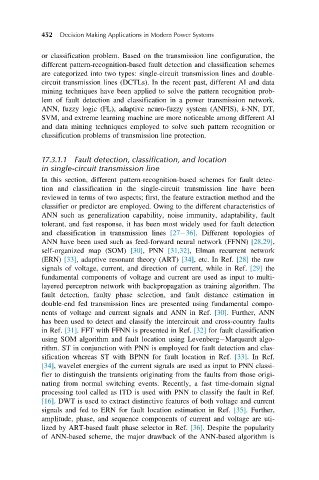Page 492 - Decision Making Applications in Modern Power Systems
P. 492
452 Decision Making Applications in Modern Power Systems
or classification problem. Based on the transmission line configuration, the
different pattern-recognition-based fault detection and classification schemes
are categorized into two types: single-circuit transmission lines and double-
circuit transmission lines (DCTLs). In the recent past, different AI and data
mining techniques have been applied to solve the pattern recognition prob-
lem of fault detection and classification in a power transmission network.
ANN, fuzzy logic (FL), adaptive neuro-fuzzy system (ANFIS), k-NN, DT,
SVM, and extreme learning machine are more noticeable among different AI
and data mining techniques employed to solve such pattern recognition or
classification problems of transmission line protection.
17.3.1.1 Fault detection, classification, and location
in single-circuit transmission line
In this section, different pattern-recognition-based schemes for fault detec-
tion and classification in the single-circuit transmission line have been
reviewed in terms of two aspects; first, the feature extraction method and the
classifier or predictor are employed. Owing to the different characteristics of
ANN such as generalization capability, noise immunity, adaptability, fault
tolerant, and fast response, it has been most widely used for fault detection
and classification in transmission lines [27 36]. Different topologies of
ANN have been used such as feed-forward neural network (FFNN) [28,29],
self-organized map (SOM) [30], PNN [31,32], Elman recurrent network
(ERN) [33], adaptive resonant theory (ART) [34], etc. In Ref. [28] the raw
signals of voltage, current, and direction of current, while in Ref. [29] the
fundamental components of voltage and current are used as input to multi-
layered perceptron network with backpropagation as training algorithm. The
fault detection, faulty phase selection, and fault distance estimation in
double-end fed transmission lines are presented using fundamental compo-
nents of voltage and current signals and ANN in Ref. [30]. Further, ANN
has been used to detect and classify the intercircuit and cross-country faults
in Ref. [31]. FFT with FFNN is presented in Ref. [32] for fault classification
using SOM algorithm and fault location using Levenberg Marquardt algo-
rithm. ST in conjunction with PNN is employed for fault detection and clas-
sification whereas ST with BPNN for fault location in Ref. [33]. In Ref.
[34], wavelet energies of the current signals are used as input to PNN classi-
fier to distinguish the transients originating from the faults from those origi-
nating from normal switching events. Recently, a fast time-domain signal
processing tool called as ITD is used with PNN to classify the fault in Ref.
[16]. DWT is used to extract distinctive features of both voltage and current
signals and fed to ERN for fault location estimation in Ref. [35]. Further,
amplitude, phase, and sequence components of current and voltage are uti-
lized by ART-based fault phase selector in Ref. [36]. Despite the popularity
of ANN-based scheme, the major drawback of the ANN-based algorithm is

